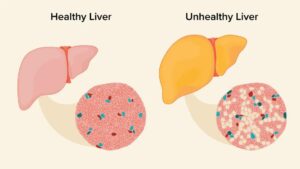
Unraveling the Mysteries of Protoporphyric Disorders
Protoporphyria stands as an uncommon genetic condition, disrupting the body’s natural process of heme synthesis, a pivotal element within hemoglobin—the protein essential for ferrying oxygen across the bloodstream. This disorder finds its place among the porphyrias, a spectrum of maladies marked by irregularities in heme production.
Unraveling the Enigma of Protoporphyria
Protoporphyria, a rare yet significant medical condition, unveils its intricacies primarily through erythropoietic protoporphyria (EPP). The genesis of this condition lies in the intricate dance of genes, particularly mutations in the FECH gene, orchestrating a deficiency in ferrochelatase, an indispensable enzyme in the final act of heme production. This enzymatic deficiency, akin to a conductor missing from an orchestra, disrupts the harmonious conversion of protoporphyrin IX into heme, setting the stage for an accumulation of protoporphyrin IX in various bodily compartments, most notably in the skin, blood, and liver.
Symphony of Symptoms: From Sensitivity to Sunlight
The repercussions of protoporphyrin IX accumulation manifest primarily through a symphony of symptoms, with photosensitivity taking center stage. Exposure to sunlight or artificial light sources serves as the conductor’s baton, initiating a cascade of painful skin reactions akin to discordant notes in an otherwise serene melody. Affected individuals experience a repertoire of discomfort, ranging from the crimson hues of erythema to the swelling crescendo of edema and the blistering finale reminiscent of a tumultuous climax.
Navigating Life with Protoporphyria: Tips and Insights
Living with protoporphyrin IX accumulation necessitates navigating a labyrinth of challenges, with photosensitivity casting a shadow over daily life. To illuminate the path forward, here are some invaluable insights and recommendations:
- Embrace Sun-Safe Practices: Shield yourself from the sun’s harsh rays by donning protective clothing, wide-brimmed hats, and sunglasses with UV protection. Seek shade during peak sunlight hours to minimize exposure;
- Harness the Power of SPF: Invest in high-SPF sunscreen and apply generously and frequently, paying special attention to exposed areas such as the face, neck, and hands. Opt for broad-spectrum formulas to defend against both UVA and UVB rays;
- Light Up Your Environment: Customize your living spaces with UV-filtering window films, curtains, and blinds to create a sanctuary free from harmful light. Consider utilizing indoor light sources with low UV emissions to mitigate potential triggers;
- Stay Hydrated and Nourished: Maintain optimal hydration levels by drinking plenty of water and consuming a balanced diet rich in antioxidants and skin-nourishing nutrients. Limit alcohol consumption, as it can exacerbate symptoms and disrupt heme metabolism;
- Forge Supportive Connections: Cultivate a network of understanding friends, family members, and healthcare professionals who can offer support, empathy, and guidance on managing protoporphyria effectively;
- Explore Therapeutic Options: Consult with healthcare providers to explore therapeutic interventions such as beta-carotene supplementation, which has shown promise in reducing photosensitivity and improving quality of life for individuals with EPP.
Understanding Protoporphyria: Diagnosis and Management
Diagnosis Challenges and Strategies
Diagnosing protoporphyria presents unique challenges owing to its rarity and the variability in its symptoms among individuals. Healthcare professionals typically employ a multifaceted approach combining clinical evaluation, biochemical testing, and genetic analysis to confirm the condition accurately. However, due to its diverse manifestations, diagnosis may sometimes require repeated assessments over time.
Key aspects of the diagnostic process include:
- Clinical Evaluation: Physicians rely on patient history, physical examination, and symptomatology to guide the diagnostic process;
- Biochemical Testing: Laboratory tests measure levels of porphyrins and other relevant biomarkers in blood, urine, or stool samples, aiding in diagnosis confirmation;
- Genetic Analysis: Molecular testing helps identify genetic mutations associated with protoporphyria, facilitating definitive diagnosis and potentially informing familial risk assessments.
Early Detection and Importance
Early detection of protoporphyria is paramount for initiating timely interventions to manage symptoms effectively and prevent long-term complications. Recognizing subtle signs and symptoms and promptly seeking medical evaluation can significantly impact disease prognosis and quality of life.
Significance of Early Detection:
- Preventative Measures: Timely diagnosis enables the implementation of preventive strategies to minimize symptom exacerbation and reduce the risk of complications;
- Patient Education: Early diagnosis provides an opportunity for patient education regarding sun protection measures and lifestyle modifications.
- Psychosocial Support: Identifying protoporphyria early allows for the provision of psychological support and resources to cope with the challenges associated with the condition.
Management Approaches and Treatment Options
While no definitive cure exists for protoporphyria, management primarily revolves around symptom control and mitigating triggers that exacerbate photosensitivity reactions. Healthcare providers collaborate with patients to develop personalized treatment plans tailored to their specific needs and symptom severity.
Recommended Management Strategies:
- Sun Protection Measures: Encourage the consistent use of protective clothing, wide-brimmed hats, and sunglasses to shield against UV radiation;
- Topical Sunscreens: Advise the application of broad-spectrum sunscreens with high SPF regularly, especially before sun exposure;
- Avoidance of Sun Exposure: Recommend limiting outdoor activities during peak sunlight hours and seeking shade whenever possible;
- Dietary Considerations: Discuss the potential benefits of a diet rich in beta-carotene-containing foods or supplements, which may offer some degree of photoprotection;
- Medications: In severe cases or during acute flare-ups, oral beta-carotene supplements or other pharmacological agents such as antihistamines or nonsteroidal anti-inflammatory drugs (NSAIDs) may be prescribed to alleviate symptoms;
- Phototherapy: Select cases may benefit from phototherapy sessions using narrow-band UVB light, administered under medical supervision to desensitize the skin to UV radiation over time.
Long-Term Care and Follow-Up
Effective management of protoporphyria necessitates ongoing monitoring and proactive adjustments to treatment strategies as needed. Regular follow-up appointments with healthcare providers facilitate symptom assessment, treatment optimization, and patient education, fostering a collaborative approach to disease management.
Components of Long-Term Care:
- Regular Monitoring: Schedule periodic check-ups to assess disease progression, monitor treatment efficacy, and address any emerging concern;
- Adaptive Strategies: Modify management plans based on individual response to treatment, evolving symptomatology, and lifestyle changes;
- Genetic Counseling: Offer genetic counseling services to affected individuals and their families to provide information on inheritance patterns, familial risk assessment, and reproductive options;
- Multidisciplinary Approach: Engage a multidisciplinary healthcare team comprising dermatologists, geneticists, and other specialists to ensure comprehensive care and support for patients with protoporphyria.
Navigating Life with Protoporphyria: Enhancing Quality of Life
Living with protoporphyria, a rare genetic disorder, can profoundly impact various aspects of an individual’s life, from daily routines to social interactions. The condition manifests in a heightened sensitivity to light, necessitating constant vigilance and adaptation to mitigate symptoms. Here’s how protoporphyria affects quality of life and strategies to enhance well-being:

1. Sunlight Avoidance and Limitations:
- Individuals with protoporphyria must diligently avoid sunlight and artificial light sources to prevent skin reactions and discomfort;
- This restriction can significantly limit outdoor activities, such as picnics, sports, or leisurely walks, affecting overall quality of life;
- Understanding the timing and intensity of sunlight exposure is crucial for planning daily activities and outings.
2. Impact on Social Interactions:
- Protoporphyria can hinder social interactions, as individuals may need to decline invitations to outdoor events or gatherings during peak sunlight hours;
- Feelings of isolation or FOMO (fear of missing out) may arise due to the inability to participate in typical social activities;
- Educating friends and family about the condition can foster understanding and support, encouraging inclusive indoor activities or evening outings.
3. Employment Challenges:
- Career choices may be limited for individuals with protoporphyria, as certain professions requiring outdoor work or prolonged exposure to light may not be feasible;
- Flexible work arrangements or remote job opportunities can provide alternatives for maintaining employment while managing the condition;
- Workplace accommodations, such as adjustable lighting or shaded areas, can enhance comfort and productivity for individuals with protoporphyria.
4. Psychological Well-being:
- Coping with the demands of a chronic condition like protoporphyria can take a toll on mental health, leading to anxiety, depression, or feelings of helplessness;
- Seeking support from mental health professionals or joining support groups can offer coping strategies, validation, and a sense of community;
- Incorporating stress-reduction techniques such as mindfulness, meditation, or creative outlets can promote resilience and emotional well-being.
5. Access to Support Services:
- Collaboration with healthcare professionals, patient advocacy groups, and peer networks is paramount for individuals with protoporphyria and their families;
- Access to educational resources, including informational websites, pamphlets, or seminars, can empower individuals with knowledge about their condition and management strategies;
- Counseling services and specialized care facilities equipped with photoprotective measures can provide tailored support and medical interventions to alleviate symptoms and improve quality of life.
Exploring the Frontier of Genetic Testing and Molecular Research
In the ever-evolving landscape of medical science, breakthroughs in genetic testing and molecular research have brought to light new horizons in our comprehension of protoporphyria, a rare genetic disorder characterized by the body’s inability to properly process certain chemicals, leading to a range of symptoms from skin sensitivity to severe pain. These advancements have not only deepened our understanding of the underlying mechanisms driving the disorder but have also opened avenues for innovative treatment strategies that hold promise in transforming the lives of those affected.
- Gene Therapy: At the forefront of experimental treatments stands gene therapy, a revolutionary approach that involves modifying or replacing defective genes responsible for protoporphyria with functional ones. This cutting-edge technique holds immense potential in addressing the root cause of the disorder at the genetic level, offering a glimpse into a future where individuals with protoporphyria may experience long-term relief from their symptoms;
- Enzyme Replacement Therapy (ERT): Another avenue of exploration lies in enzyme replacement therapy, which seeks to supplement deficient enzymes in individuals with protoporphyria. By providing the body with the enzymes it lacks, this therapy aims to restore normal metabolic processes, thereby mitigating the symptoms and complications associated with the disorder. While still in its experimental stages, ERT holds promise as a potential treatment option for managing protoporphyria.
Advancing Research for Future Solutions
The quest to conquer protoporphyria does not end with current treatment modalities. Ongoing research endeavors are pushing the boundaries of knowledge and innovation, striving to uncover novel therapeutic targets and develop more efficacious interventions for individuals grappling with this challenging condition.
- Identification of Therapeutic Targets: Researchers are delving deep into the molecular intricacies of protoporphyria, scouring for new therapeutic targets that hold the key to unlocking more effective treatment options. By elucidating the pathways and mechanisms underlying the disorder, scientists aim to pinpoint specific molecular targets that can be manipulated to modulate disease progression and alleviate symptoms;
- Collaborative Initiatives: Collaboration is paramount in the pursuit of advancements in protoporphyria research. Interdisciplinary collaborations between researchers, clinicians, and pharmaceutical companies foster synergistic efforts, pooling together diverse expertise and resources to accelerate progress in understanding and combating the disorder. Through collaborative initiatives, researchers can leverage collective knowledge and infrastructure to propel the development of novel therapies and improve outcomes for individuals afflicted with protoporphyria.
Conclusion
Protoporphyria stands as an uncommon genetic anomaly marked by heightened sensitivity to light and irregular heme synthesis. Despite the substantial hurdles it presents to those afflicted, strides in scientific inquiry and medical care offer promise in comprehending and addressing this condition. Through heightened consciousness, backing research endeavors, and furnishing holistic support, we endeavor to elevate the well-being of individuals grappling with protoporphyria, aspiring toward a more optimistic horizon for all grappling with uncommon ailments.

